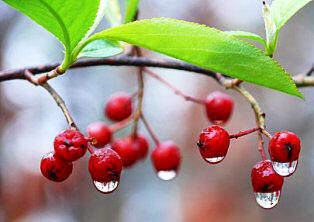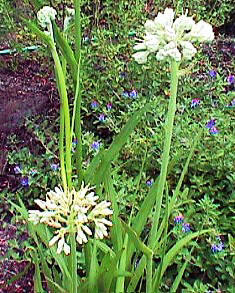Discover Florida Nature
It's time to explore the natural Florida


|
|
|
|
|
Browse through our alphabetical list of native Florida plants that
encourage butterflies into your garden, and find the perfect choices for
your Florida butterfly garden! Plants that have an asterisk beside their
name are especially high in nectar. Red
Chokeberry
(Aronia arbutifolia)- Red Chokeberry is a common upright, open
shrub with white flower clusters in spring and red fruits in fall and
winter. Two garden-worthy species of Aronia, Red Chokeberry and Black
Chokeberry, occur over a wide range of Eastern North America, including
Florida. Both are highly drought tolerant, fruitful and beautiful year
round. In the spring they cover themselves with two inch clusters of
tiny sweet scented flowers. Flowers are followed by lots of shiny green
berries that mature over the summer, eventually turning bright red or
black depending on the species. The bright red fruits last throughout
the winter. By late fall, deep green foliage changes to a brilliant
flaming red. Brilliant Red Chokeberry, is an improved red-fruiting
cultivar. It's one of the few deciduous shrubs that can equal burning
bush when it comes to great fall color. Red
Chokeberry
(Aronia arbutifolia)- Red Chokeberry is a common upright, open
shrub with white flower clusters in spring and red fruits in fall and
winter. Two garden-worthy species of Aronia, Red Chokeberry and Black
Chokeberry, occur over a wide range of Eastern North America, including
Florida. Both are highly drought tolerant, fruitful and beautiful year
round. In the spring they cover themselves with two inch clusters of
tiny sweet scented flowers. Flowers are followed by lots of shiny green
berries that mature over the summer, eventually turning bright red or
black depending on the species. The bright red fruits last throughout
the winter. By late fall, deep green foliage changes to a brilliant
flaming red. Brilliant Red Chokeberry, is an improved red-fruiting
cultivar. It's one of the few deciduous shrubs that can equal burning
bush when it comes to great fall color.  Redroot
(Lachnanthes caroliniana)- Redroot has a large root, with a red or brown
skin, containing many small, white veins. The stems are from two to four
feet high, and slender, with many reddish, round, smooth branches. The
leaves of the Redroot are ovate or oblong-ovate, and three veined,
Redroot leaves are rather smooth above, with soft, reddish hairs
beneath, and are often heart-shaped at the base. The flowers are minute,
white, in long, crowded panicles from the axils of the upper leaves.
Redroot is indigenous to the United States, and is abundant in Florida.
Redroot grows in dry woodlands, and
hammocks, flowering
from June to August. The leaves are astringent and slightly bitter, and
have been used as a substitute for tea, to which they have a strong
resemblance when dried, both in taste and odor. The root is the
medicinal part, and has a taste and smell somewhat resembling those of
the peach leaf. It has been occasionally used for coloring. Redroot
(Lachnanthes caroliniana)- Redroot has a large root, with a red or brown
skin, containing many small, white veins. The stems are from two to four
feet high, and slender, with many reddish, round, smooth branches. The
leaves of the Redroot are ovate or oblong-ovate, and three veined,
Redroot leaves are rather smooth above, with soft, reddish hairs
beneath, and are often heart-shaped at the base. The flowers are minute,
white, in long, crowded panicles from the axils of the upper leaves.
Redroot is indigenous to the United States, and is abundant in Florida.
Redroot grows in dry woodlands, and
hammocks, flowering
from June to August. The leaves are astringent and slightly bitter, and
have been used as a substitute for tea, to which they have a strong
resemblance when dried, both in taste and odor. The root is the
medicinal part, and has a taste and smell somewhat resembling those of
the peach leaf. It has been occasionally used for coloring. Staggerbush
(Lyonia spp)- Staggerbush is a much branched evergreen shrub
with clusters of globular flowers. Plant twigs are the most distinctive
feature as they zig-zag at each node. Its preferred habitat is wet
thickets and swamps. Distribution is throughout the Escambia region of
Florida. The leaves of the staggerbush are about three inches long;
alternate on the stem; oblong to oval and finely toothed. The new leaves
are small and scruffy, becoming smooth on the upper surface. The margins
are entire and slightly rolled under. The tip is blunt. The mature
leaves have lateral veins that are impressed on the upper surface.
Staggerbush flowers are small; constricted at the tip, and pale rose or
white. The calyx lobes are triangular. Flowers occur in early spring,
but the shrub is known to flower in early summer as well. The
Staggerbush fruit is a round, berry-like capsule persisting through the
winter. These blueberry-like shrubs are frequently associated with
wooded swamps. The genus name honors the early American botanist and
explorer John Lyon, who died in 1818. Staggerbush
(Lyonia spp)- Staggerbush is a much branched evergreen shrub
with clusters of globular flowers. Plant twigs are the most distinctive
feature as they zig-zag at each node. Its preferred habitat is wet
thickets and swamps. Distribution is throughout the Escambia region of
Florida. The leaves of the staggerbush are about three inches long;
alternate on the stem; oblong to oval and finely toothed. The new leaves
are small and scruffy, becoming smooth on the upper surface. The margins
are entire and slightly rolled under. The tip is blunt. The mature
leaves have lateral veins that are impressed on the upper surface.
Staggerbush flowers are small; constricted at the tip, and pale rose or
white. The calyx lobes are triangular. Flowers occur in early spring,
but the shrub is known to flower in early summer as well. The
Staggerbush fruit is a round, berry-like capsule persisting through the
winter. These blueberry-like shrubs are frequently associated with
wooded swamps. The genus name honors the early American botanist and
explorer John Lyon, who died in 1818.
|
|
|
Advertise | Privacy Statement | Contact | Alaska Nature | Michael Arnold Art| Dog Encyclopedia | Dog Encyclopedia| |
|